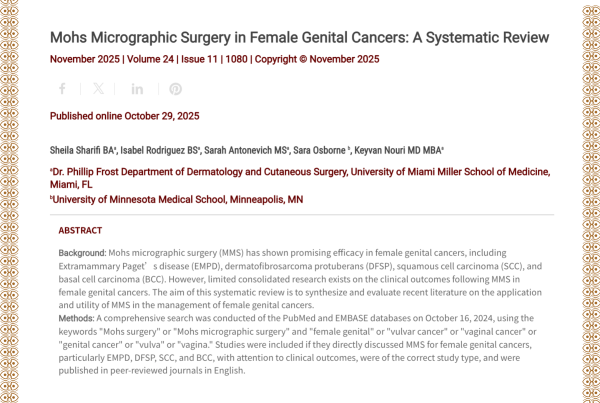Skin Cancer Case Reports
Using 31-Gene Expression Profile in Melanoma Risk Prognosis
Because the American Joint Committee on Cancer’s (AJCC) staging system guidelines are based on pathology alone, there is controversy surrounding this staging and how accurate it is at predicting mortality and morbidity in patients diagnosed with primary cutaneous melanoma.
.
A Case of Cutaneous Blastic Plasmacytoid Dendritic Cell Neoplasm Treated With a Bcl-2 Inhibitor
We discuss a case of a male patient in his late 70s’ who presented with an asymptomatic rash involving the back and the right knee that initially developed as pink patches, progressed into plaques, and subsequently rapidly evolved into a tumor involving the right knee that was confirmed as blastic plasmacytoid dendritic cell neoplasm on skin biopsy and was accompanied by bone marrow involvement. Upon initiation of first line tagraxofusp-erzs therapy, the patient did not achieve improvement.
.
Sponsored
Hedgehog Inhibitor as Eye-Sparing Neoadjuvant Treatment for Locally Advanced Periocular Basal Cell Carcinoma
This patient’s tumor successfully responded to hedgehog inhibitor allowing surgical excision with clear margins. The orbit was saved in a patient who otherwise would have required complete orbital exenteration.
.
Rapid Evolution of a Squamous Cell Carcinoma In Situ to Locally Invasive With Perineural Involvement
As many as 31% of squamous cell carcinoma in situ (SCCis) may have a component of invasive SCC that is missed on initial histology due to sampling bias. This case reminds us that sampling bias can occur during biopsy.
.
Combination Topical Chemotherapy for the Treatment of an Invasive Cutaneous Squamous Cell Carcinoma
Standard of care for squamous cell carcinoma (SCC) is usually surgical, with either excision or Mohs micrographic surgery. However, surgery may not be ideal for elderly patients with numerous lesions, who are poor surgical candidates or who refuse surgery.
.
Recurrent Squamous Cell Carcinoma Arising Within a Linear Porokeratosis
Here we report a case of linear porokeratosis with recurrent malignant degeneration to squamous cell carcinoma (SCC) recurring six years after excision of initial SCC. A 79-year-old woman presented with a friable tumor located within a longstanding lesion on her posterior thigh. Six years prior, she was diagnosed with SCC arising within the same lesion, which had been surgically excised with negative margins. Physical examination revealed a 3.5 x 2.7 cm friable tumor on the left proximal posterior thigh.
Basal Cell Carcinoma in the Nasal Vestibule
We report the first case of basal cell carcinoma skin cancer arising in the nasal vestibule. The lesion was treated with Mohs micrographic surgery and required three stages to obtain histological clearance. Given the location of the tumor, Mohs surgery was chosen due to the procedure’s effectiveness for achieving the highest cure rate with the lowest incidence of tumor recurrence and for preserving as much adjacent healthy tissue as possible.
Sponsored
Podcast Episodes
Support the (On)cause: A Practical Review of Supportive Oncodermatology
Dr. Mario Lacatoure joins podcast host Dr. Adam Friedman to discuss the array of cutaneous clusters that not only can, but are almost expected to occur during cancer therapy. Learn how even simple OTC products can contribute to both ameliorating and even preventing some of these sequelae.
Variations in Skin Cancer Screening Practices Among Dermatologist
Dr. Adam Friedman and Dr. Evan Rieder (double-board certified in dermatology and psychiatry) discuss his recent study entitled “Dermatologist Practices During Total Body Skin Examinations: A Survey Study.” Do we all do it the same? Are we all checking every nook and cranny? Do we need better standardization for our greatest weapon to enable early and life saving skin cancer detection?
Supplements
Skin Cancer in Hispanics in the United States
The Hispanic population in the United States has reached nearly 58 million in 2016 and has been the principal driver of U.S. demographic growth, accounting for half of national population growth since 2000. Hispanics are the youngest major racial or ethnic group in the United States. About one-third, or 17.9 million, of the nation’s Hispanic population is younger than 18, and about a quarter, or 14.6 million, of all Hispanics are Millennials (ages 18 to 33 in 2014), according to a Pew Research Center analysis of U.S. Census Bureau data.










